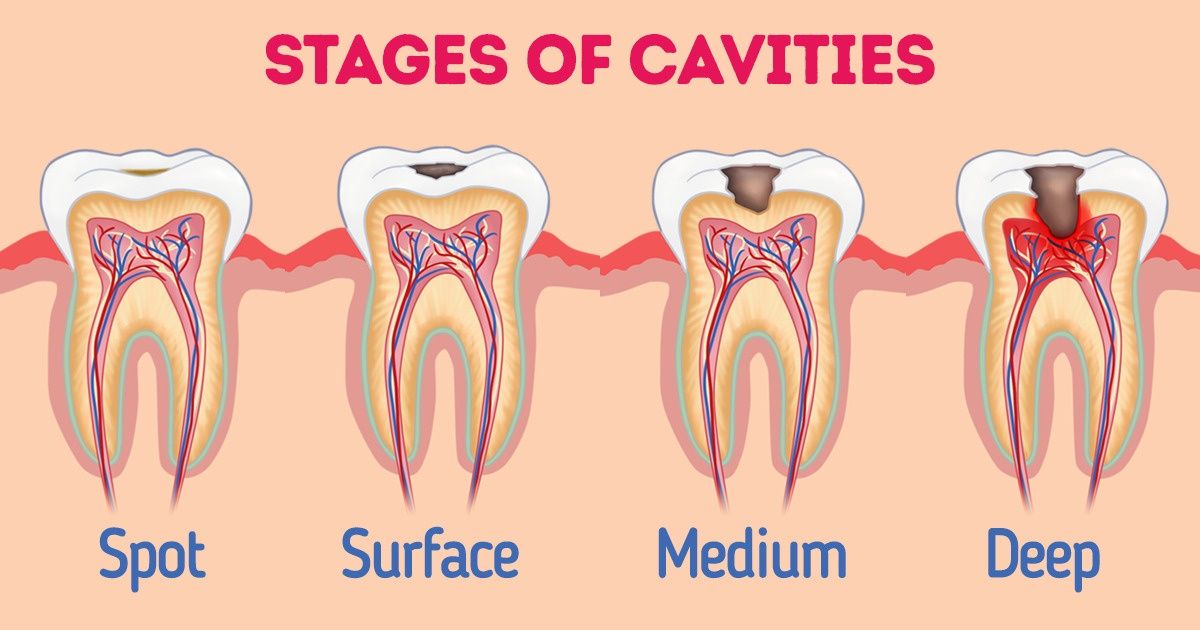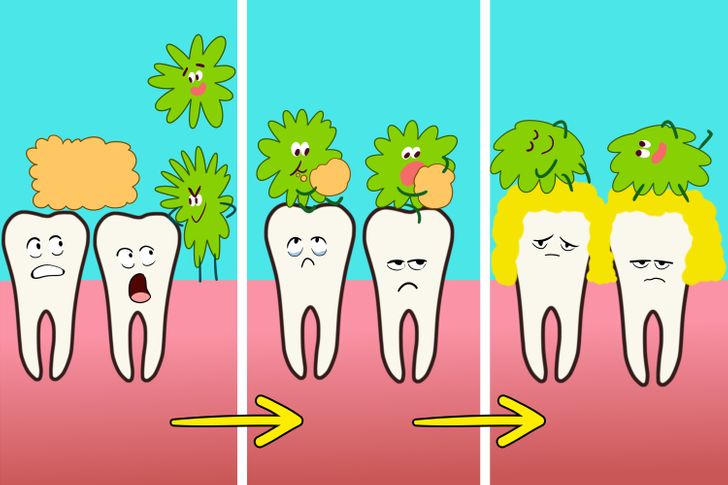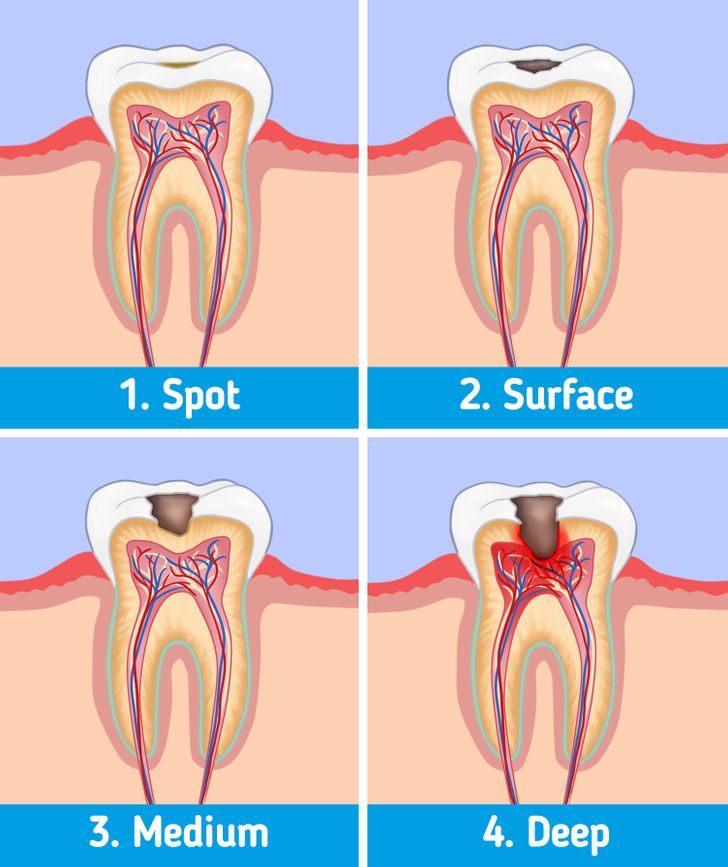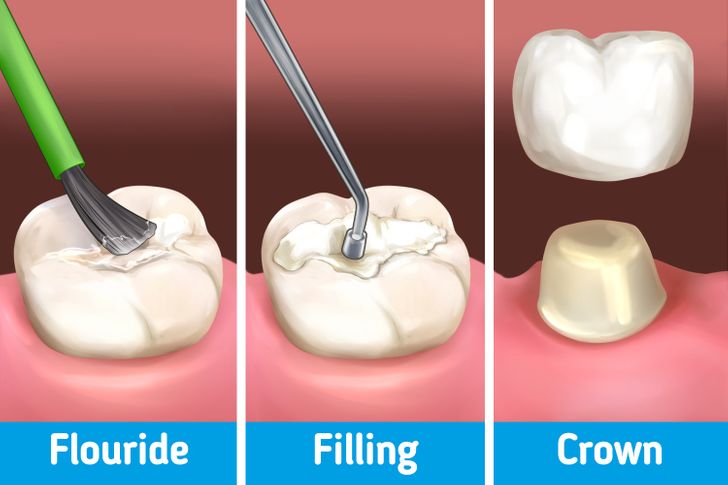What Cavities Are and How to Avoid Them

Tooth decay is the most widespread tooth condition among people. According to the World Health Organization, 2.3 billion people around the world have cavities. But the interesting thing is that cavities are easy to prevent and treat in the early stages.
5-Minute Crafts is going to tell you about cavities, their symptoms and stages, and the types of treatments that dentists offer. We are also going to share some recommendations on how to prevent cavities and other tooth problems.
❗The information in this article is for education. You need to see a doctor to have cavities diagnosed and treated.
What cavities are

When we eat high-carb foods, the bacteria in our mouths turns them into acids. As a result, we have plaque on our teeth. If you don’t remove it, it might solidify and turn into tartar. Tartar is really hard to remove and it protects the bacteria.
After a while, the acids will start to weaken the tooth enamel, get deeper into the teeth, and create cavities in them. If you don’t treat them, the cavities will become bigger and the acids will go even deeper. It might cause severe pain and even lead to infections and tooth removal.
What increases the risk of cavities
Some factors increase the risk of cavities. For example:
- Tooth location. Cavities mostly affect the back teeth. They have a lot of deep crevices where bacteria might build up. They are harder to brush than the smooth front teeth.
- Poor mouth care that leads to more dental plaque and faster enamel destruction.
- Certain foods and drinks. Milk, ice cream, honey, soda, cakes, cookies, and chips are harder to remove with saliva than other foods. As a result, they remain on the teeth for a longer time giving more energy to the bacteria to produce the acids.
- Lack of fluoride. Fluoride is a natural mineral that helps to prevent cavities. This is why fluoride is often added to toothpaste and mouthwashes. A lack of fluoride makes teeth more vulnerable to bacteria and the acids they produce.
- Mouth dryness. Saliva helps wash off food leftovers. Some medications and conditions may lead to low saliva production and mouth dryness.
- Young or old age. Cavities are mostly found in young children and teenagers. Also, the elderly are in this risk group — with age, the gums might become lower, and teeth are worn out, so they are more vulnerable.
Stages of cavities

1. Demineralization. At the first stage, the tooth enamel starts losing minerals because of the dental plaque. As a result, white spots appear on the surface. The damage may be neutralized if you use fluoride-containing toothpaste and visit a dentist. They will clean your teeth professionally.
2. Enamel destruction. If the enamel continues to be damaged, the white spots will become brown, and small cavities will appear on the teeth.
3. Dentin decay. Over time, the cavities will become bigger, and the bacteria will get deeper into the dentin — the part of the tooth that is right under the enamel. It’s softer and more vulnerable to acid. You might have unpleasant sensations when eating or drinking something hot or cold.
4. Pulpitis. Then, the acids will go into the layer under dentin. Nerves and blood vessels are there. When cavities reach this layer, you will have sharp pain and the area around the tooth will swell. You need very fast treatment at this stage. If you do nothing, the tooth will have to be removed.
Symptoms of cavities
At early stages, you might not even notice cavities. But the more your teeth are damaged, the more often you will have these symptoms:
- toothache for no reason
- tooth sensitivity when you eat or drink something hot, cold, or sweet
- grey, brown, or black spots
- unpleasant smell or taste
- visible cavities in the teeth
- gum redness and inflammation
How to treat cavities

The treatment of cavities can only be done by a dentist. The actual way depends on the stage:
- Fluoride. If it’s only a spot, a professional cleaning and fluoride application will help restore the enamel.
- Filling. If there’s a cavity on the tooth surface, the dentist will remove the destroyed tissue and fill it.
- Root treatment. If cavities reach the center of the tooth, you might need root treatment. The dentist will remove the destroyed tissue, clean the canals, and then give you a filling or a crown if needed.
- Tooth removal. When the tooth is so damaged that it can’t be treated, the dentist will remove it.
How to avoid cavities
- Be serious about your mouth hygiene. Brush your teeth at least twice a day, use fluoride-containing toothpaste, and use tooth floss regularly.
- Use floss and mouthwash every time you eat something sour with a lot of carbs (especially citrus and chocolate).
- Use tooth sealants. A sealant is a protective cover that is put on the surface of the back teeth. They cover the holes to prevent food pieces from getting in. Sealants can function for several years before they need to be replaced. Discuss this with your dentist.
- Eat less food with sugar. Have a healthy and balanced diet with many fruits and vegetables that increase saliva production.
- Visit your dentist regularly. Cavities are easier and cheaper to treat at early stages. Dentists might be able to notice them during a simple examination and prevent further problems. Visit your dentist at least every 6 months.
- Use fluoride. If you are not getting enough fluoride, discuss applying it to your teeth to protect them from cavities.